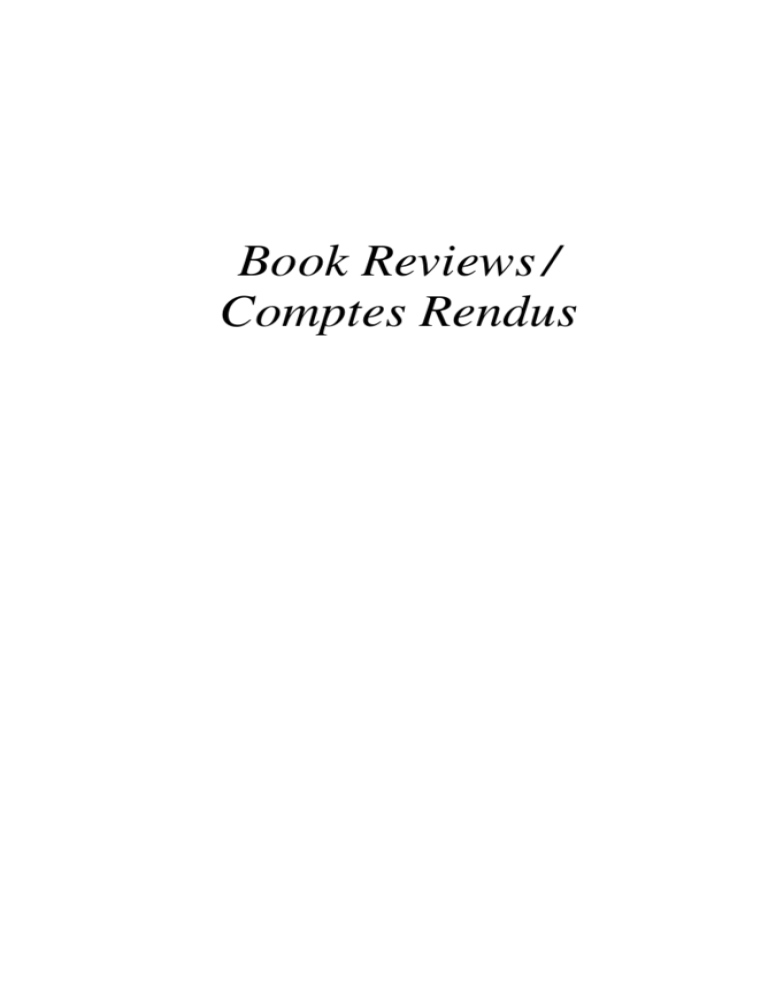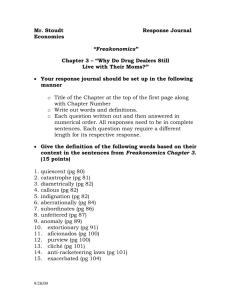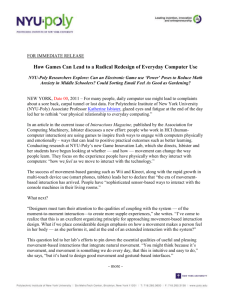Independent Thought and Caribbean Community
advertisement

Book Reviews / Comptes Rendus LABOUR, Capital and Society 37 (2004) pp. 299-313 TRAVAIL, capital et société 37 (2004) pp. 299-313 BOOK REVIEWS / COMPTES RENDUS Kari Levitt. Reclaiming Development: Independent Thought and Caribbean Community. Kingston, Jamaica and Miami, Florida: Ian Randle Publishers, 2005, 411pp. Few people are as eminently qualified to write about the pressing issue of economic development in the Caribbean as Kari Levitt. For more than 40 years she has married the measured intellectual rigour of a trained economist with a passionate sense of social justice. Levitt, Emerita Professor of Economics at McGill University and the former George Beckford Professor of Political Economy at the University of the West Indies, is of a generation and time, not too long gone, when economics, politics, and social policies were seen as one and indivisible; a time in which economics was not simply a discipline of statistics, data, and indices, but about real human needs and concerns and their relation to the social and physical environment. Kari Levitt’s life has been dedicated to social change and in Reclaiming Development: Independent Thought and Caribbean Community, she brings to bear her experience as an economist who has lived and worked in the Caribbean as a researcher, analyst, and lecturer from the 1960s through to the 1990s (Levitt presently lives in Montreal but she continues to spend much of her time in the Caribbean, Trinidad and Tobago in particular.) In this collection of essays, originally penned between 1983 and 2002, Professor Levitt revisits her longtime collaboration with Lloyd Best, one of the Caribbean’s most important economists and social analysts, and their joint work on the Plantation Economy. The Plantation Economy represents an attempt by Best and Levitt to elaborate an economic framework for the Caribbean. The ideas stem from reflections by Allister McIntyre, Best, and Levitt in Trinidad in 1964. Drawing on the broad socio-economic history of the Caribbean, the framework divides the region into what Levitt describes as “successive ‘modifications’” of the original Caribbean 299 plantation economic system. The Plantation Economy consists of the following historical models: I. Slave plantation; II. Postemancipation; and III. Modernization and ‘development’ following the labour unrest of the 1930s and the Second World War. Model IV represents the anti-model, “a self-sustaining, selfreliant economy which has transcended metropolitan dependence and the economic and social legacy of the plantation system.” This last stage anticipates economic and social change, change whose character and form remain to be determined. After decades of collecting dust, this important theoretical contribution to Caribbean economic theory will soon see the light of day as both Levitt and Best have been working feverishly to finalize it for publication. Reclaiming Development also analyzes the Caribbean’s precipitous accumulation of debt and the shift from the postcolonial euphoria of the 1960s and early 1970s to the sordid reality of the present in which social malaise, economic dependence, and political capitulation conspire to suffocate the life chances of the Caribbean’s most marginalized. A big part of this story lies in the history of Bretton Woods and the swing from Keynesian economic policies. This transition included the transformation of the World Bank and IMF into fiscal managers for powerful financial institutions and a policy broker for Western, primarily American foreign economic policies. Reclaiming Development is saturated with insights on Caribbean political economy but, by far, the most intriguing part of the book is Professor Levitt’s correspondence with Michael Manley, former prime minister of Jamaica. The backdrop of these letters, which were exchanged between 12 December 1995 and 23 July 1996, is that Manley was acutely ill. Considering that he died just over a year after the last of the letters were exchanged, the correspondence represents one of the most important testaments to the legacy of Michael Manley’s political tenure in Jamaica, hearkening back to a time when he was the acknowledged defender, not only of Jamaica’s underprivileged, but one of the Third World’s most prominent ideologues. Levitt poses some difficult, probing questions to the then retired Manley, so much so that one gets the sense that the sensitive Manley feels stung by the frankness of her inquiries which touch 300 upon the policies of his government in the 1970s and 1990s. The People’s National Party returned to office under Michael Manley in 1972, riding a wave of popular sentiment. At the time, the mining of bauxite and aluminum manufacture were prized industries in the international market. In the early 1970s, Manley took the decision to nationalize the bauxite industry. His government invested in schools, infrastructure, and health and these reforms helped to raise many of Jamaica’s poor, predominantly Black underclass, into the ranks of the middle and ruling classes. Manley also took a strong stand internationally. He was an outspoken critic of the Apartheid regime in South Africa and openly demonstrated support for the Cuban and later the Grenada Revolution. But with the declining price of bauxite and other primary products on the world market in the mid-1970s, Jamaica took a financial beating, resulting in high unemployment and the inability of the government to deliver on many of its promises. Manley defends the collapse of his social policies in the face of Levitt’s accusations that his rhetorical socialism was not matched by sound economic planning, and that his government squandered Jamaica’s precious reserves which were accumulated during the prosperity of the late 1960s and early 1970s. He warns Levitt against excessive academic pedantry, imploring her to take into account the unstable political climate in the country at the time. Apart from the increasingly violent political posturing of the opposition Jamaica Labour Party (JLP), the tumultuous environment was also being fueled from without by a hostile U.S. foreign policy and the presence of the C.I.A. in Jamaica, a fact that, as Levitt agrees, is far too well documented to be given short shrift. Respectful in her delivery, Professor Levitt nonetheless reserves her most biting criticism of Manley for his economic policies of the 1990s. Under the guise of ‘liberalization’ and establishing a ‘level playing field’, these policies exposed Jamaica’s economy to the free reign of multinational corporations by lifting trade restrictions. Coupled with a whopping four billion dollar debt load that was incurred during the reign of Edward Seaga’s JLP, liberalization has been disastrous, resulting in the collapse autochthonous industries, particularly in the agricultural sector, the facts of which have been brilliantly documented in the film Life and Debt. Manley’s defense 301 of his about face in the 1990s leaves a lot to be desired. Reading his letters, it is hard to shake the sense that, in the face of a decimated official left throughout the world, and immense pressure form the United States, the IMF and the World Bank, Manley capitulated, though it is quite possible that he could not envision any other economic alternative. We are also left to imagine the thoughts of the ailing, dignified, but obviously shaken former prime minister as he witnesses Jamaica’s crumbling social and economic state in his last days. The correspondence ends on an inconclusive note as the correspondents agree to publish the letters so that the next generation can continue the discussion. As a result, we are left with one of the most important exchanges on the exigencies of social and economic development in the Third World that exists in the public record. Reclaiming Development is not without its weaknesses. For example, one would have liked to share in Professor Levitt’s insights on both the Cuban and Grenadian Revolutions as alternative modes of development (she does suggest that Cuba is the only country to have even marginally broken with the plantation economic model). The book also suffers from repetition, largely the result of the fact that the essays are taken from lectures for which it was important to describe the historical and social context for each presentation. Despite these minor shortfalls, Reclaiming Development represents a very important contribution, not only to development praxis in the Caribbean, but to development in the underdeveloped world. It forces the reader to think hard and fast on the meaning of development, well beyond the wizardry of the increasingly myopic discipline of economics. It prefigures a world in which the term ‘social capital’ is not simply a shibboleth or catch phrase, but one that encourages ‘investment’ in, and the participation of, the vast majority of the people of the Caribbean and the underdeveloped world in creating a society worthy of the title developed. This book deserves a central place in the classrooms of college and university campuses and wherever discussions on development and the Caribbean are taking place. David Austin Director, Alfie Roberts Institute, Montreal 302 Alberto Spektorowski. The Origins of Argentina’s Revolution of the Right. Indiana: University of Notre Dame Press, 2003, 269 pp. The author seeks to deconstruct the stereotypes that those persons belonging to the Right are comfortable with, namely antimodernist reactions and opposition to modernity and democracy; whilst the Left is usually linked to revolutionary changes. The book reflects in-depth research and objective analyses that will allow the reader to comprehend the intricate political evolution and dynamics of the Argentine society. Spektorowski dissects Argentina’s multi-layered ideological bedrock, which existed between 1930 to 1943, and the transition from conservative authoritarianism to the revolution of the Right. It is particularly important in understanding how certain ideas emanating from the European conservative revolution were utilized by antidemocratic Argentine intellectuals to influence anti-liberal political elites in the interwar era. The construction of alternative ideological models provided the stamp of approval for anti-liberal politics. Chapter One examines the conservative revolutionaries and a new type of organic nationalism that resulted in the foundation for a theory of political and cultural freedom for ‘dependent’ societies outside of Europe. The author argues that the corrupt politics, cultural decay and economic reliance on Britain were mainly responsible for the intellectual revolt. In Chapter Two, the immigrants in Argentina are portrayed as possessing a tenuous link with their new homeland. Despite refusing to be active in the political life of Argentina, immigrants were enticed by anarchists to join “combative syndicalist organizations” in an ongoing effort to fight the political system (p.42). The global dimension of the spread of ideas is also brilliantly featured in this work, particularly the fact that republican ideas of the French Revolution had influenced liberal elites from Argentina and Latin America. Another illustration is the identification of Argentine nationalist upheaval as being a significant part of a worldwide phenomenon in which there was an upsurge of rightwing ideological developments amidst radical technological progress and expanding capitalism. Undoubtedly, the various newspapers and magazines such as the Bandera Argentina, Baluarte and Crisol were an indispensable medium which assisted in the rapid spread of ideas in Argentina. 303 In The Origins of Argentina’s Revolution of the Right there is a concerted attempt to clearly enunciate the nature of Peronism. Spektorowski believed it was not merely restricted to being an ideology and agrees with other thinkers who viewed it as a particular social experience that had been identified as a structure or community of feelings. Interestingly, the author argues that this unique feeling partly constituted the “ideological corpus of the new nationalism” which incorporated total subservience to the political leader and disgust for formal democracy (p.206). Chapter Four “The Década Infame” examines the emergence of wavering support of new nationalisms. During this ‘conservative restoration’ period, two strains of nationalism appealed to the public—integralist and populist nationalisms. The Fascist influences on the integralist Right contributed to differences between both types of nationalism. Another noteworthy aspect of this chapter is the historical revisionism by intellectuals. This movement intended to not only criticize the political and economic situation but also define Argentina’s cultural identity. Furthermore, it also incorporated a criticism of Argentina’s oligarchy. During the early 1930s in Argentina, the desire for social justice and appeals for transparency among politicians created the necessary impetus for promoting nationalist sentiment. Chapter Five “The Integralist Right and the Populist Left” highlights the fact that ideas on social justice and political corporatism were promoted by groups, such as Legion Cívica and Ligon Republicana. This book also explores the religious sphere amidst the political scenario. This was an unexpected but welcome consideration of the tension between the religious and secular domains. Catholic nationalists were not keen on accepting that Fascism represented a global revolutionary spirit. The Catholics faced a dilemma since Fascism posed a threat to liberal democracy and the Church’s interest. Nevertheless, the Catholic nationalists acknowledged the fact that Fascism during the interwar era “…was part of a political tradition that combined communication values and a modern approach to politics” (p.109). The influential role of right-wing Catholics in bridging the gap between the Church and army was briefly addressed in “The Military in Power and Early Peronism”. The complexities of Argentina cannot be easily compared to other developing countries. It is a land with multifarious political 304 ideologies and nationalisms: liberal democracy, traditional federalism, republican populist democracy, constitutional populism, left and right-wing nationalists, Yrigoyenist nationalism and authoritarianism. Additionally, the usage of terms such as patriada and uriburismo suggest that political development in Argentina is unparalleled. Another illustration is the concept of hispanismo that was a search for identity. It was an attempt to recreate a new Argentina that would purge itself of alien ideologies, such as socialism and liberalism, and develop unique socio-political systems. Interestingly, the ideological ferment unfolding in Argentina during the early decades of the twentieth century was not duplicated in the neighbouring Caribbean. The impact of unorthodox ideologies was confined mostly to the hierarchy of Caribbean working class organizations and trade unions. Indeed, The Origins of Argentina’s Revolution of the Right cannot be easily dismissed as just another text on the history or politics of Argentina’s past. This work will be an invaluable handbook for today’s radicals and revolutionaries who will certainly appreciate the vital role of ideas, rather than violence, in mobilizing the people and creating sociopolitical change. Jerome Teelucksingh University of the West Indies, Trinidad Dennis C. Canterbury. Neoliberal Democratization and New Authoritarianism. Aldershot, UK: Ashgate, 2005, 210 pp. Neoliberal Democratization and New Authoritarianism argues that democratization being promoted by the World Bank, the International Monetary Fund (IMF) and the US government only reinforces domestic political authoritarianism in order to maintain global capitalism. It makes this general claim based on analyses of Guyana’s political economy. This book could be described as a case study with a structuralist critique drawing on class analysis. The analysis explains the weaknesses of current international democratization efforts. The strength of the book lies in its analysis of the contemporary and historical roots on domestic political authoritarianism in Guyana. A limitation of the book is that it is a case study of Guyana but it makes more general claims about its analysis and conclusion. 305 Neoliberal Democratization and New Authoritarianism examines the evolution of political economy in Guyana. The book can be broken into four or five parts: chapter one introduces the argument; chapters two and three examine the colonial period; chapters four, five and six examine the early post-colonial period, the 1950s-1970s; and, chapters seven, eight and nine examine the current period, 1980s-2000s. Chapter nine also acts as a concluding chapter. Canterbury finds that global capitalism was established in Guyana during the colonial period at which time aboriginal people were conquered and capitalist class came to dominate the economy at the expense of the working class. Chapter three examines the growth of class-consciousness and the establishment of trade unions. This chapter also finds the roots of race-based identity and organization being the result of middle-class pressures from different racial groups (p.51). Canterbury argues that race-based identity waters down class-based identity and was a deliberate strategy of the colonizer as a means of control. This race-based identity is identified later in the book as the chief reason why democratization has only led to more authoritarianism. Chapter five examines the establishment of the post-colonial one-party state and finds that it reinforces domestic social and economic degradation. Chapter six goes on to find that, to the detriment to working people, trade unions became subordinated to the one-party state. During the post-colonial period the state took over control of the means of production but became a vehicle of capitalism. Ownership of industry in Guyana aggravated race-based conflict as different industries were dominated by different racial groups. Chapter seven examines how economic stagnation of the 1970s and 1980s led to global capitalist pressure against domestic political elites to democratize (p.135). Chapter eight examines the consequences of structural adjustment on Guyana’s economy and unions. Chapter nine then examines how democratization in Guyana, driven by global capitalism has only reinforced domestic authoritarianism. Democratization has been introduced into Guyana through various organizations such as the World Bank and the IMF. But this has been driven not by the benevolence of global capitalism as this democratization has only reinforced domestic political authoritarianism in Guyana and ensured Guyana’s 306 dependent participation in the global economy. New authoritarianism is the result of race-based political division that has been encouraged by global capitalism. The strength of this book is its detailed structuralist analysis of Guyana’s political economy during the late colonial and early postcolonial period. This provides an understanding of the roots of the complex political situation in Guyana and makes clear that simple recipes for democratization from the outside are not likely to succeed. The author builds on important works by Clive Thomas, James Petras and Henry Veltmeyer, and neo-Marxist scholars such as Robert Chilcote. The author argues that it has been external forces, in alliance with internal elites that have over time undermined Guyana’s capacity to achieve true democracy and development. The argument would have been strengthened if the book dealt in more detail with the current political economy in Guyana. This analysis is limited to chapters eight and nine and chapter nine also acts as a conclusion. Considering the central role that race-based identity plays in explaining the new authoritarianism, the book would have been strengthened by elaborating on this point. For instance the author states, Elections were held in the post-colonial authoritarian state but they were not free and fair. Under the new authoritarianism, elections are considered to be somewhat free and fair but only one group wins power because of racial voting (p.181-82). In earlier chapters the author explained how race-based identity was created under colonialism and maintained in the early post-colonial period. The author argues that past authoritarian politics explain the present authoritarianism. The analysis would have been strengthened with more analysis of why present-day race-based identity reinforces this situation. Overall Neoliberal Democratization and New Authoritarianism is a worthwhile case study of a domestic political economy’s relationship with global capitalism. The analysis of Guyana is useful to understand this complex relationship and lessons can no doubt be applied to understanding the political economy of similar countries. Jerry Buckland Menno Simons College, Winnipeg, Manitoba 307 John Isbister. Promises Not Kept: Poverty and the Betrayal of Third World Development, 6th ed. Bloomfield, CT: Kumarian Press Inc., and Hampshire: Palgrave Macmillan, 2003, 272 pp. Isbister’s Promises Not Kept is an extremely interesting reader for students in development studies. Moving across disciplinary boundaries involving development economics, development sociology, anthropology, history, political science, international relations, and so on, Isbister reaffirms the interdisciplinary nature of development studies. Students who wish to delve further into subjects like Third World poverty, theories of underdevelopment, imperialism, nationalism, foreign policy issues of development, with special emphasis on foreign aid can gain a balances and wide-ranging view of available knowledge on the said subject areas. The book has eight chapters, with six of them covering the above six topics. Of the other two chapters, the first provides an introductory overview of the subject areas covered in the book. The concluding chapter covers the author’s insights about how the on-going process of globalization can be tamed to provide social justice to the developing world. The book has a useful bibliography and an index. The comparative method adopted by Isbister is one of the major strengths of this book, at a time when most readers of this nature would present what the writer subscribes to. Isbister divides development theory into three schools of thought, modernization, dependency and Marxist schools. This classification and his allocation of subject content to each school are somewhat problematic. The author is aware of these problems as he writes: “These three schools do not exhaust the ways that have been used to understand world poverty. Furthermore, the disagreements within the schools have often been as great as the gaps between them” (p. 31). By adopting the comparative method, Isbister treats the reader with respect, and provides her/ him the option of deciding which available explanation would agree with the facts of poverty in the Third World today. As Isbister argues, “… social reality is infinitely complicated, confused, and puzzling. … Society can be thought of as a ball of tangled strings. …. All the explanations are ‘true’, but they are also partial and therefore in a way untrue, because they do not comprehend the full complexity of the ball of strings” (p. 57). The bibliography at the end offers the interested reader useful 308 guidance to key publications on various aspects of the debates about development, which she/ he had read in the text. Isbister brings history back into development studies. In an insightful chapter on Imperialism, Isbister argues that “imperialism shaped today’s Third World” (p. 66). He continues to argue that traditional cultures of the Third World are rich and various and that old folkways of the Third World have little to do with poverty as it exists there today. It is indeed good to remind the young generations — presumably the main target of Isbister’s book — of the critical role European imperialism had played in bringing about underdevelopment. These young generations, born after the dissolution of much of the European empires, are nevertheless living in a world where the exploitative principle of colonialism continues to operate in its neo-colonial garb. The location of poverty and underdevelopment in its proper historical context reminds the reader that material poverty in the Third World is not something natural or traditional but a phenomenon that was created by human beings themselves. Isbister has devoted a fair share of the book for a discussion of dependency theory with all its pessimistic conclusions about the potential for development in the present world context. A substantial amount of historical material is also covered to show many development failures. It is refreshing however, that the author always concludes with an optimistic note. The title of the book may give the impression that it is a book of criticisms and complaints. No doubt, there are a lot of these but the author does not stop at criticisms. There is always a positive message. The following seems to encapsulate the message of the whole book (p. 28): Still the prosperous countries and their institutions — their governments, armed forces, corporations, voluntary associations — powerfully affect the constraints within which the Third World must determine its future. Having played a significant role in the creation of the world’s inequities, they could allow themselves to be used constructively. They will not help by being missionaries, by trying to bring the ideology of free markets or even democratic institutions to the Third World. The people of the poor countries will do that well or badly by themselves, and there is not much that the rich can do about it. Their responsibility is to reform their own institutions, to lend a hand that is open and not clenched, to be helpful and not 309 harmful to the world’s poor. This is a task that is achievable and is also respectful of the Third World, not manipulative. In the concluding chapter, Isbister comes back to his optimism for Third World development, highlighting the potential space that is available for an agenda for constructive action in the form of restraints on forces of globalization to be implemented at national level. Isbister shares the humanist view of development that development is about people. In this perception, development would cover many things — GDP growth, environmental sustainability, distributional equity and satisfaction of basic human needs. The “promises not kept” and the “betrayal” of the Third World, in the title of the book, refer to the failures of numerous paths different societies have taken in the past to achieve this multifaceted development. Examining the relevant historical record, Isbister shows how the promise of development held out by movements involving (i) nationalism and political independence, (ii) socialism and government planning; (iii) industrial growth and shift away from agriculture, (iv) foreign aid and capital investment, (v) investment in human capital and (vi) the “new international economic order” has failed to be kept in much of Africa, Asia and Latin America. He then refers to the resurgence of neo-liberalism since the 1980s — a decade lost to economic development as the Third World was “waylaid by the debt crisis” (p. 180). His prognosis for the twenty first century, though rather bleak, is worth taking seriously so that suitable corrective measures could be taken in time: “At the beginning of the twenty-first century, the market was king and all else fell before it. It is unlikely to retain this ascendancy forever. Unless the market can produce a decent life for all the people of the Third World, not just a chosen few, it will come under attack in the future. Reliance on the international market may well join the long list of nostrums — including socialism, state control, capital formation, foreign aid, and the new international economic order — that were once thought to be the key to economic development but that eventually proved unequal to the task”. (p. 189). Isbister’s book reviews the problems of and policies for development in the Third World using a very wide analytical framework. This wideness of canvass is both its strength and 310 weakness. The strength is that it enabled Isbister to present a balanced comparative view of the debates and controversies involved, making the book a useful and interesting reader for students and development workers. The weakness emanating from the extremely wide subject coverage of the book is that it fails to develop any one of the many interesting themes encountered to an adequate depth. In spite of this weakness, Isbister’s Promises Not Kept must be strongly recommended as an interesting reader in development studies. W. D. Lakshman University of Colombo, Sri Lanka Von Holdt, Karl. Transition from Below: Forging Trade Unionism and Workplace Change in South Africa. Pitermaritzburg: University of Natal Press, 2003, 325pp. As Editor of South African Labour Bulletin for many years, Karl Von Holdt played an important role in energizing the research/ practitioner role in South African labour studies. Now with this, his PhD research concluded at Wits University, he makes his mark as a singularly talented writer on the role of workers, trade unions and community in the dismantling of South Africa’s apartheid system. This is a book that will appeal to the South African specialist but also all who are concerned with developing the new international labour studies. It contributes an in-depth longitudinal study of the Highveld Steel plant and thus empirical substance to often ‘overpoliticised’ debates on South African trade unionism. But it also adds conceptual rigour — described from the best of international labour history and comparative labour sociology — to a field that is often rather particularistic in its empiricism. While much of political science occupied itself with the elite negotiations and pacts that led to a transition from the apartheid regime to democracy, this book focuses on the ‘transition from below’. It was in the workplace, at the trade union meetings and in the town council where most workers negotiated and constructed their opposition to apartheid against what he calls ‘metropolitan industrial sociology’. Von Holdt focuses less on the generation of order or the manufacture of current but rather in the ‘generation of disorder’. Confronting the apartheid workplace and regime in the 311 factory and in the community, South Africa’s workers helped to make the apartheid regime unsustainable. And the workplace was crucial because the regime needed to expand industrial production and for that it needed an educated and reasonably contented workforce. Even the petty divisions and regulations of apartheid in the workplace were to become counterproductive for capitalism. Von Holdt tells the story of the workers of Highveld Steel based in Witbank, a quarter of a million strong city, some 150 kilometres east of Johannesburg, a typical apartheid town in many ways. NUMSA (National Union of Metalworkers of South Africa) who came to organize the workers at Highveld was one of the largest affiliates to COSATU (Congress of South African Trade Unions) and a key pillar of the new independent black unions existing in the 1980s. This study engages with how this union organized its steel workers at Highveld and came to play a crucial role in their struggle for survival and a dignified life in the workplace and community. The tension between migrant workers and the settled urban workers of Witbank is an important part of his story, as is the synergy and tension between the workplace and the community. Migrant workers often saw the township residents as ‘unreliable’ and not firm in the struggle. Township residents often resented the migrants for their different wages and their sometimes brutal militancy. From being a ‘white man’s factory in a white man’s country’ the Highvelt steel plant passed into a key focus of the struggle against apartheid. The internal dynamics of the apartheid workplace regime are followed meticulously with a wealth of life history input ‘from below’. But the author also moves out into the broader community and national political scene. What we get is a bridging of the usual gap between its detailed particularistic workplace study and the rather abstract disembodied natural political accounts of labour’s advance. There is also a balance in this account between engagement with the struggle of workers and an ability to see the downside, contradictions and limitations of workers’ struggles. It does not end with the promised land after the unbanning of the ANC and Nelson Mandela taking on the role of President. But nor does Von Holdt join the often facile chorus of critics of the ANC from an abstract leftist standpoint. There is no way to summarize this book in a review; it simply needs to be read. What is worth taking up perhaps is Von Holdt’s 312 critique of the ‘social movement unionism’ views that was quite influential in South Africa. He argues that ‘where the literature assumes social movement unionism is primarily class-based, this study finds an amalgam of popular and class identities’ (p. 10). But in its Latin American usage the SMU concept and strategy was based precisely on a critique of class essentialism and the importance of popular interpellations. Be that as it may, Von Holdt has done a free service to international labour studies with this rich empirical and conceptually informed study of a group of South African workers, their unions and their community in a crucial turning point in that country’s history. It should contribute to contemporary studies of workers in the era of globalization, their problems and prospects. Ronaldo Munck Dublin City University 313






